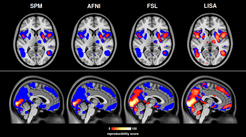LISA: a new method of statistical inference in neuroimaging
New method detects brain activations with improved sensitivity and accuracy
One of the principal goals in functional magnetic resonance imaging (fMRI) is the detection of local neuronal activation in the human brain. However, lack of statistical power and inflated false positive rates have recently been identified as major problems in this regard. The group of scientists of the Max-Planck-Institute of the Biological Cybernetics and the University Hospital in Tuebingen came up with a new software framework called “LISA” to address these problems.

The most widely used statistical inference procedures were invented more than 10 years ago and are not well suited for handling state-of-the art high-resolution neuroimaging data. MRI technology improved considerably in recent years due to the advent of ultra-high field scanners (>= 7 Tesla) that offer greatly improved spatial resolution. However, standard algorithms were not designed to handle such high-precision data so that some of the main advantages of ultrahigh-field scanning were lost due to inadequate software. Furthermore, a recent publication showed that some of the most widely used statistical methods sometimes produced incorrect results.
Reasons enough for our scientists to invent better approaches for statistical inference in fMRI. Gabriele Lohmann from the Max Planck Institute for Biological Cybernetics explains:” Sophisticated mathematical methods are needed in order to make sense of neuroimaging data. The colored 'blobs' that are often depicted in articles on neuroimaging are computed using complicated statistical methods. Without those tools we would not be able to see anything in these data.”
The scientists now introduced a new method of statistical inference in fMRI, which they call LISA (Local Indicators of Spatial Association). It is inspired by a concept otherwise used in geographical information systems. In conclusion, the scientist hope that because of its improved sensitivity and better spatial specificity, LISA will help in developing novel and more realistic models of human brain function. Lohmann further elaborates: “In our first tests, we found that our method is much more sensitive and can detect brain activity more accurately than previous methods. We are convinced that our method will help to provide a more complete understanding of the brain function.” She is convinced that for the future, the insights gained from this basic research may benefit patients with neurological diseases.
BF
